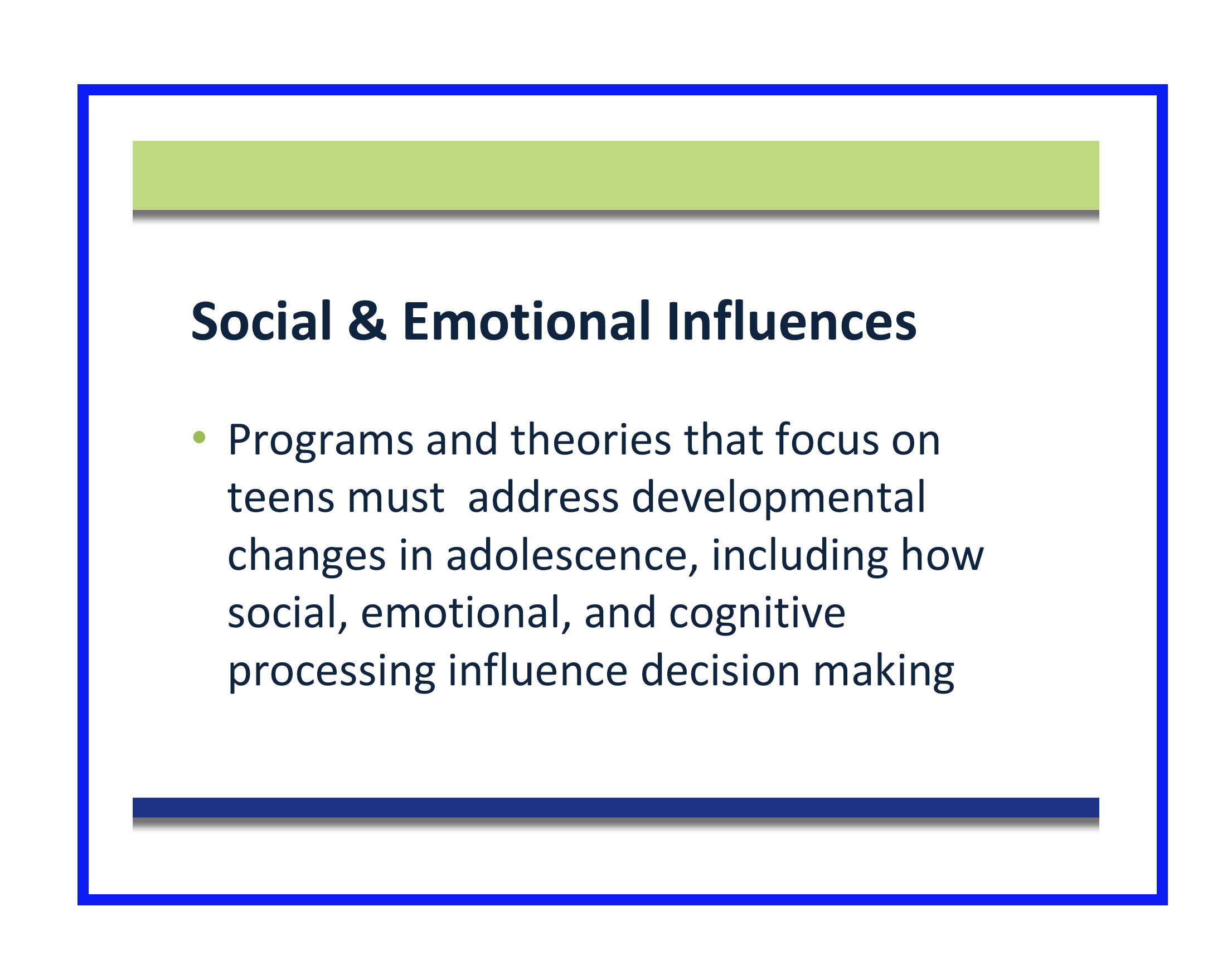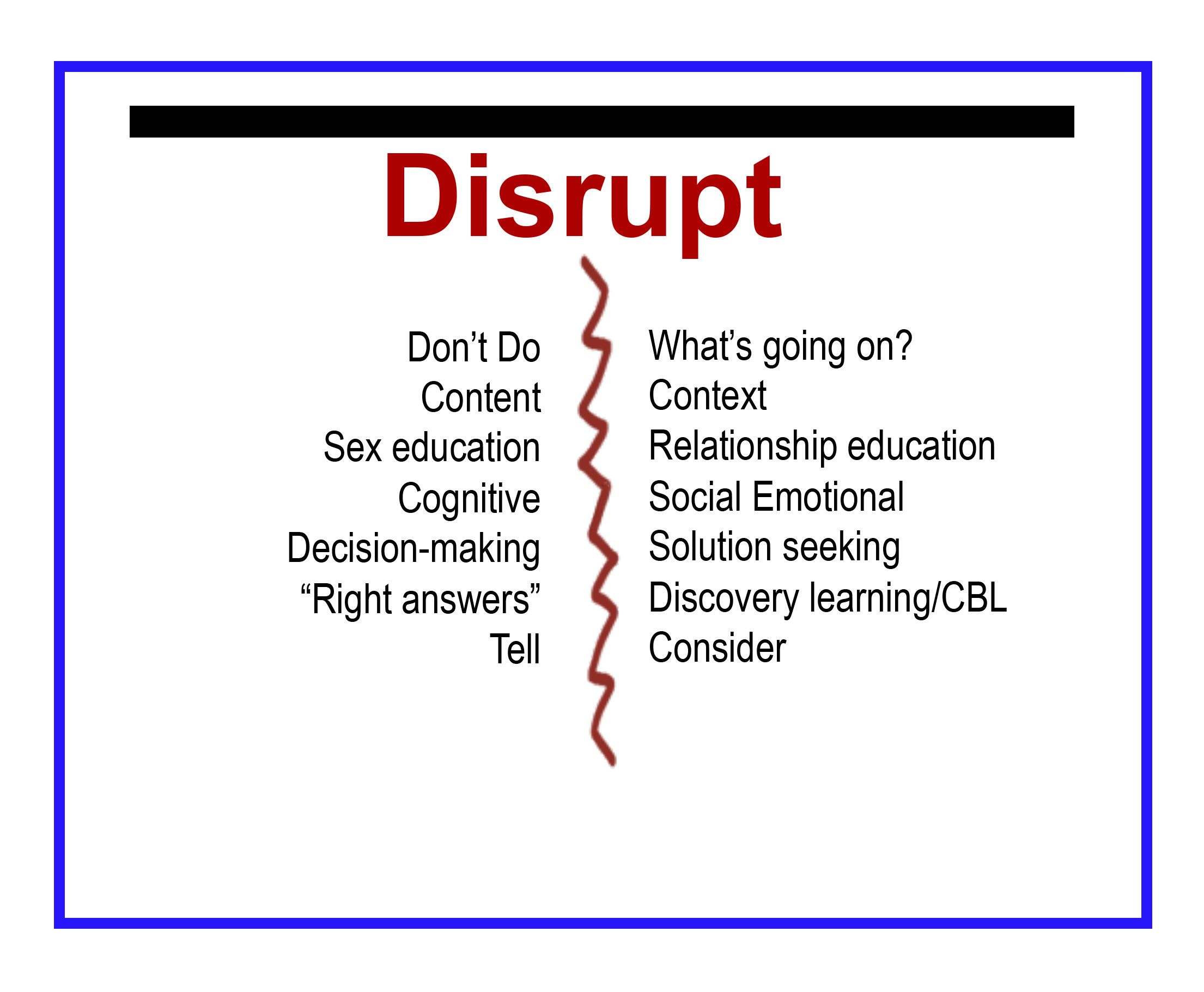Disrupt Your Thinking: It's Good for Sexual Health Education
By Karin Coyle, PhD | February 6, 2018
The Kirby Summit has disrupted the ways I think about sex education. I hope it’s going to disrupt your thinking, too. ETR’s invitational Summit assembled some of the nation’s best-known developmental neuroscientists, along with similarly respected sexual and reproductive health specialists. The things we’ve learned by bringing our disciplines together are altering the ways all of us are conceptualizing sex education.
What our 2016 and 2017 Summits made clear is that we need to approach sexual health and risk reduction education differently, drawing on other science to guide us in aligning our work developmentally and, as a result, offering more impactful experiences.
This involves examining the content we teach and, perhaps more importantly, how we teach that content.
What’s This Mean?
In presentations stemming from the first two Kirby Summits, we often ask people to reflect on the key developmental tasks of adolescence. Most offer thoughts such as developing key aspects of identity, exploring new perspectives on friendships and romantic relationships, navigating more complex emotional experiences, navigating sexually maturing bodies, taking risks, and preparing for adulthood.
Indeed, it’s all this and more. The social, emotional and cognitive development that occurs during this time nudges young people towards learning about the social complexities needed throughout adulthood. It also provides opportunities for shaping our sexual health content and how we teach that content.
A Look at Content
Let’s start with the content. Many of the current evidence based programs have a strong cognitive emphasis (here’s what you should or shouldn’t do, reasons why, and steps to take). This comes at the expense of spending time exploring social and emotional influences on behavior. Indeed, I found myself reflecting that much of our sexual health education is emotionless. Truly a missed opportunity.
We know from the developmental science that in moments of high emotional arousal (e.g., in new situations, with friends, in romantic relationships), adolescents’ decisions are based more on what they’re feeling and less on what they’re thinking (see this post by Stephanie Guinosso and our 2017 Kirby Summit brief for more information on these principles).

Focusing on Emotions: 3 Strategies
As a result of the Summits, it’s clear we need to bring more emotional elements into our programs, and do so in a way that is appropriate for a classroom context. Here are three strategies we are using. Please share how you have done this in your programs!
- Use storytelling. We are developing and testing programs that integrate storytelling into the lessons. When students discuss stories about believable situations involving youth who feel real to them, they become more emotionally involved as they think about decisions, influences and consequences.
- Have students practice skills and report back. If students have been practicing skills in class, like asking for consent, for example, they might be given an assignment to practice these approaches with a friend or romantic partner (e.g., consent to borrow something personal, or share someone’s food, or share a hug). They can report back in class about how it felt to use these strategies with people who are important to them, and discuss what they might do differently next time.
- Use short video clips. Students can watch a short video clip that has emotion in it, then discuss what advice they might give the characters. A successful clip will capture some of the emotions students are feeling in their own lives and serve as a conversation starter.
A Look at Skills
We can also look at what skills we teach and expand our current programs to align with key developmental tasks. One of the most common skills most programs teach is how to push others away (refusal skills). We do this to youth at a time when social relationships and social status are central to their developing identities.
Can we do better? I’m not suggesting we give up on helping young people stand up for their boundaries, but we do need to reflect on how we are doing this. We promote autonomy and agency when we teach about consent, how to communicate without abuse, and ways to negotiate different boundaries. These skills help young people navigate their relationships—they flip the orientation from one of pushing someone away to one of staying engaged socially without compromising personal values and boundaries.
“How” We Teach
Another area we discussed at the Summits was one of our framing and “how” we teach. Most of the evidence-based HIV/STI and pregnancy prevention programs available were designed from a risk reduction viewpoint, as opposed to an adolescent development frame. This misses opportunities to tap into natural developmental levers like promoting autonomy, focusing on relationships, and pursuing social justice.
We talked about a 2016 study by Bryan, Yeager and colleagues that uses adolescents’ values for autonomy and social justice to create a program addressing unhealthy eating. The program allowed young people to explore the idea of healthy eating as a way to take a stand against the “manipulative and unfair practices of the food industry.” It sparked motivation for behavior change using key values that are heightened during adolescence. This is an exciting approach to explore for issues related to sexual health.
Further, many of the evidence-based programs have a strong “teach by telling” approach. Some of the more experiential elements (e.g., call or visit a clinic) get dropped due to logistics or fear of controversy. We know from a few recent developmental science studies with adolescents that “telling” triggered neural responses opposite to what was desired (anger instead of motivation or behavior change).
We could benefit from programs that engage young people in a meaningful and authentic conversation about what’s really going on in their lives. We could allow them to come up with solutions and share options to consider, rather than just telling them what not to do and discounting what they are experiencing.
As an example, young people constantly tell us they want to talk about relationships more—how to develop and maintain them, how to deal with the digital world, how to know when it is time to end them, and what to do after they end. Teaching about relationships is an excellent way to bring in more of the emotional influences. It also taps into the values that are peaking for young people, such as autonomy, social acceptance, and even social justice.
There are many ways to recognize and respect the healthy, natural drives of adolescence and use those to empower our educational efforts. Let’s continue to draw from the developmental science to strengthen our approaches for greater impact, and keep the conversation going on how to best do this.
Go For It! Disrupt!

Remember, the evidence-based programs we have to date do work, but their impacts tend to be relatively short-lived. As educators, researchers and program developers concerned with the welfare of youth, we can do better. We want to create positive change and desired effects that last even longer. And to do that, we must continue to reflect, refine, evaluate, draw on the science, and reach to other disciplines for inspiration.
Karin Coyle, PhD, is ETR’s Chief Science Officer. She specializes in the development and evaluation of health prevention programs, with a focus on HIV, other STD and pregnancy prevention.




